Managing Traffic Congestion: The Case for a Congestion Tax
Info: 7363 words (29 pages) Dissertation
Published: 9th Dec 2019
Tagged: Social PolicyTransportation
Executive Summary
Traffic congestion is rapidly developing into a major problem in Australia. This case study examines the concept of a congestion tax and how it can be used to manage the increasing demand for driving. International case examples are compared with existing Australian policies to spark further debate on the advantages and disadvantages of a congestion pricing scheme. Detailed analysis about the root cause of traffic congestion uncovers the serious dependency on private vehicle transportation. Perspectives from various stakeholders are reviewed to formulate the link between congestion charges and improvement in public welfare. Microeconomic theory is used to further examine the validity of such a tax with the focus placed on stimulating behavioural change amongst Australian motorists.
Introduction
Over the past decade Australian cities have seen a rapid rise in traffic congestion. The roads and freeways of urban centres have experienced increased traffic volumes. This has resulted in an increased burden for existing transport infrastructure with cities unable to cope with the rising demand. The policy response by local and state level government has focussed on building new infrastructures such as roads, tunnels, bridges as well as improving the reliability and availability of public transport. These policy instruments have been centred around the supply side of the equation, however, many are arguing this is not enough to tackle the issue over the long term. There are growing calls to implement a policy based on congestion charges to better manage the increase in vehicle volumes (Pearce and Pinto 2015).
Supporters of congestion pricing argue that it will reduce the number of vehicles within the urban centres. The tax uses the fundamentals of economics to reduce the demand for road space and total vehicles on the road. They argue this will result in an improvement in traffic flow and travel times to the CBD will be reduced (Moran et all 2016). Opponents argue that the tax might be regressive, overreaching on public freedom and won’t necessarily increase public welfare (Pearce and Pinto 2015). There are also fears that the charging scheme could reduce business investment in the major cities, particularly in the retail sector.
There is also a debate in the community if such a scheme might further increase the level of inequality. Additionally, questions about the moral hazards of a congestion tax have been raised. (Levine and Garb 2000). Enthusiasm for a congestion pricing scheme has risen due to successful international case examples. Advocators such as the Grattan Institute have recommended that Australian governments should implement a pricing scheme to better manage the traffic congestion challenge. The independent report produced by the Grattan institute “Stuck in traffic?” highlights many of the external costs around traffic congestion and provides several recommendations to local and state governments around reform.
Motorists would be the primary beneficiaries from a congestion tax as it would reduce overall travel time and road accidents whilst increasing confidence in time per trip reliability. As a stakeholder motorists want less congestion but would rather not pay for it (BITRE 2014). State and local governments are continuously facing the challenges of providing transport infrastructure services to meet the rapidly increasing demand. They face the financial burden of both the costs of infrastructure and the regulatory burden around managing the demand by motorists. Governments in Australia have been less attracted by the concept of a congestion tax due to influences by both private business and public interest groups (Manners 2014).
The Problem and Policy Challenge
This case study elaborates on the relationship between traffic congestion and the broader economy. Amongst the various solutions, congestion pricing is debated to be a useful mechanism for reducing overcrowding on roads (Manners 2014). To investigate the feasibility of an urban congestion tax the vested interest of the stakeholders must be understood. These viewpoints form the basis of a link between a congestion tax and increase in public welfare. The challenge faced by policy makers is confirm if each of the chains along this link are both true and applicable for the Australian context.
The Great Australian Drive – Our Dependency On Vehicles
Australians are now more dependent on their cars than ever before (BITRE 2014). The historical dependency on cars has resulted from a combination of urban sprawl and high income per capita, which correlates with high rates of vehicle ownership (Moran et all 2016). Over the past seven decades, Australian cities have transformed from tightly knit layouts (‘core-and spoke configurations’), which are well suited to support mass transport systems, into a sprawling suburbia (low-density) configurations (BITRE 2014). This transformation of urban form has demanded an increase in overall travel time per trip due to the increase in distance travelled. This demand has been met with improvements in road infrastructure (freeways, tunnels, highways) as well as growth in car ownership. The high rate of car ownership and urban sprawl has resulted in a high dependency of private vehicle transport in Australia, particularly for work (Moran et all 2016). Australia’s growing dependency on vehicles as the primary mode of transport is evident in Figure 1. Even though the aggregate levels of alternative transport methods have experienced growth, their proportional share amongst all forms of transport have fallen since the second world war. This is further illustrated by Figure 2. The relationship between private vehicle usage and the gross domestic product per capita (GDP-per capita) as shown by Figure 3, signifies the tendency to use cars as personal wealth increases.
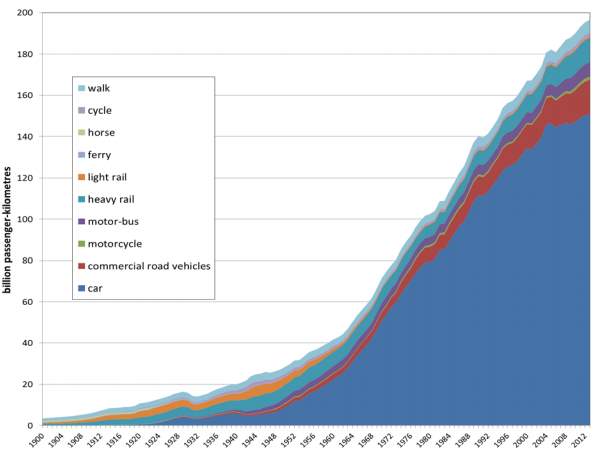
Figure 1: Distribution of Total Metropolitan Transport Methods (BITRE 2014)
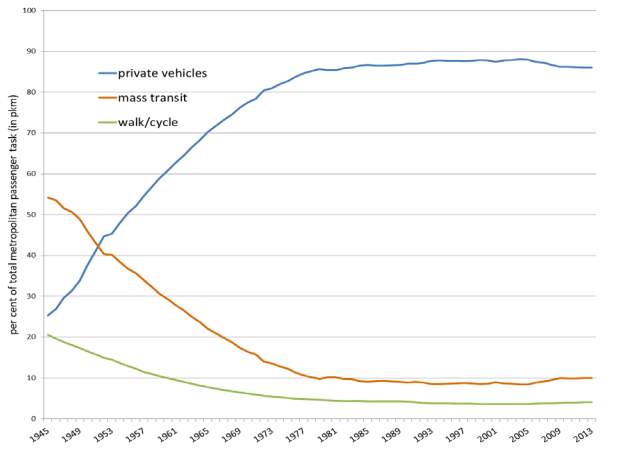
Figure 2: Aggregate modal shares for passenger transport within Australian capital cities, 1945–2013 (BITRE 2015)
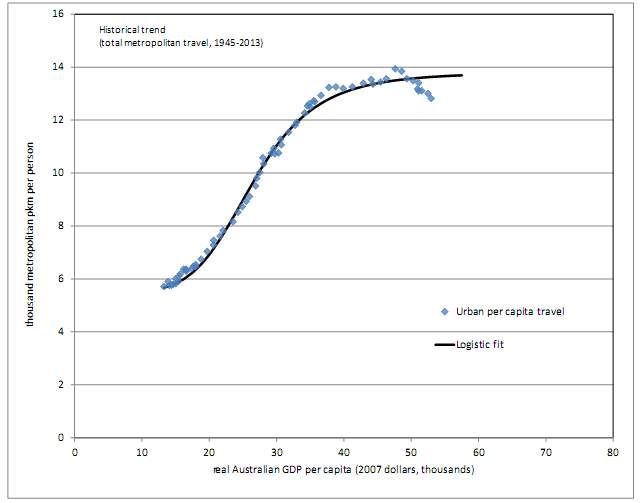
Figure 3: Relationship of per capita Australian urban travel to per capita income levels (BITRE 2015)
Population growth has also contributed to the increase in the demand for driving. The rapid rise in Australia’s population has placed extreme pressure on existing transport infrastructure, especially in our major cities (Melbourne and Sydney). This coupled with a high dependency on cars and the elevated levels of car ownership has led to soaring levels in private vehicle transport.
Demand Versus Supply –The Infrastructure Challenge
Policy makers in government have used concepts from microeconomics to model policy solutions to help reduce traffic congestion. There has been a case to absorb the increase in the demand for driving by upgrading transport infrastructure, primarily in road transport (Frost 2013). Increasing the supply of road-space comes with its challenges, most notably is the cost. Improving existing infrastructure and building new transport networks is time consuming, complicated and very expensive. An example is Sydney’s proposed West-Connex tunnel, which is projected to cost upwards of $17 billion (TheWestConnex Challenge 2017). There is also the opportunity cost of using public funding, which could have been diverted towards alternative areas. The long lead times that are associated with large infrastructure projects, make it difficult to predict if future supply will meet actual demand (Frost 2013). The concern with a supply focused model is that it doesn’t adequately account for the extra demand that is generated by increasing supply itself. This economic problem illustrates how policies for traffic congestion should address both the demand and supply side variables.
Engineers Versus Economists – Measuring Traffic Congestion
Roads tend to be labelled as “congested” when the number of vehicles using them causes unacceptable levels of delay and discomfort (Falcocchio 2015). However, the term “unacceptable” can mean different things from different points of view (Terrill 2017). To paint a clearer picture the Grattan Institutes report authored by Marion Terrill uses the three perspectives of Economists, Engineers and Motorists.
For motorists the road is deemed to be congested if the traveling speed is reduced or if the time taken to complete the trip is too long. The ‘expected travel time’ is however subjective and is best measured using a comparison model (Falcocchio 2015). A proven comparison model uses traffic data from the middle of the night versus peak hour to give detailed insight on how motorists define congestion (Terrill 2017). Reliability is also a key indicator in understanding congestion from the perspective of the motorists. Arrival time needs to be predictable with a high degree of confidence. Motorists care more about trip length predictability then the trip length itself.
Engineers define the road as congested when the technical capacity of the road is reached. The capacity is defined as the maximum number of vehicles the road can carry (Terrill 2017). This figure is also known as maximum throughput and doesn’t account for extra delays or time lost due to decreasing vehicle movement speeds. The concern with this definition is that it doesn’t capture the cost of time, it simply equates congestion to the maximum carrying capacity of the road.
The economist perspective focuses on the cost and benefits that motorists experience at different points of in traffic flow. Attention is given to the difference between the private cost and social cost per additional trip (also known as the marginal social cost). The private costs are primarily incurred by the motorists which includes the cost of fuel, tolls, car usage and the drivers time. The marginal social cost includes the private costs plus any external costs the trip places on the wider community (Terrill 2017). These external costs present themselves as the extra travel time for other motorists, environmental issues and wellbeing of the wider community.
Business Versus Consumers – Cost Benefit Analysis
Placing an accurate value on the cost of congestion is essential for tailoring effective policies. The economic cost must account for the external cost of traffic imposed by motorists as well as the direct cost to the driver. The report by the Bureau of Transport Regional Economics in 2007 proposed there are three methodologies used behind calculating the cost of traffic.
1. Total Cost of Congestion— This is the cost that resembles the total value of the delays due to traffic. It is calculated by comparing the free flow speeds versus peak hour traffic flow speed.
2. External Cost of Congestion— This is the portion of the cost that each road user imposes on others. It can be thought of as a ‘per capita cost’ as it’s proportionally calculated.
3. Deadweight Loss Cost of Congestion (DWL)—This is the net increase in social value if a traffic management plan was in place and traffic levels were optimised. It allows for costs related with a reducing traffic (business, retail, public, etc) to be compared with the social benefits of reducing congestion (in dollar terms). The BTRE report from 2007 uses the dead weight loss cost calculation to compute Australia’s economic cost of congestion which is seen in Figure 4. Major contributors towards these ‘avoidable’ social costs are due to:
- Extra travel time
- Travel time variability
- Increased operating costs (higher fuel consumption)
- Environmental costs (Poor air quality, leading to lower health outcomes for the broader society)
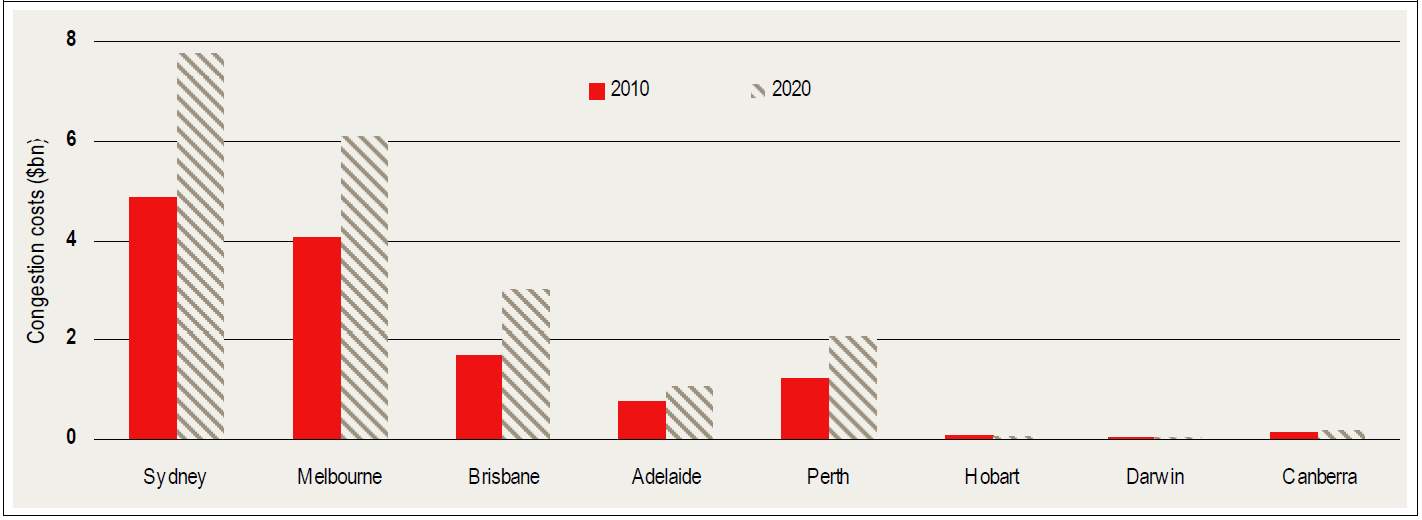
Figure 4: Congestion costs across Australia’s major cities (Manners 2014 & BTRE 2007)
Congestion Pricing – The Economic Theory
The principals behind congestion pricing are based around the standard economic theory of efficiency and externalities. A price mechanism is used to make motorists aware of the wider social cost they impose on others. The instrument internalises the externality costs caused by motorists allowing drivers to make socially efficient decisions about traveling on roads. It is a form of Pigouvian tax as it increases the private marginal cost upwards closer to the social marginal cost of traffic mobility.
The standard model of congestion derived by (Santos 2005) is illustrated in Figure 5. In this model it is assumed the simple road is a uniform lane with no junctions. All road users are identical apart from their willingness to pay for their trip, which is displayed as the curve D or also known as the marginal private benefits (MPB). The marginal social benefits (MSB) and (MPB) are assumed to be identical. The equilibrium point in this market is point B where the demand curve intersects the marginal private costs (MPC) also known as the average social cost (ASC) (Santos 2005). The efficient equilibrium point is point C, where the marginal social cost (MSC) meets the marginal willingness to pay (MPB/MSB). The inefficiency illustrated by the model is due to motorists not paying the marginal social cost of driving which is shown as the dead weight loss (DWL), measured by the area ABC. Congestion pricing works by internalising the cost resembled by the dead weight loss. This theory indicates that a tax levied correctly would reduce the traffic flow from q0 to qe and raise revenue equal to the are CFGE as seen in Figure 5.
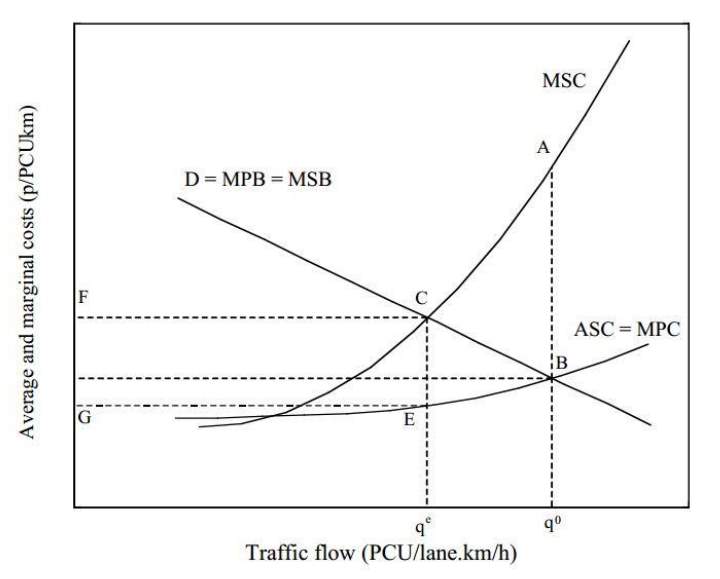
Figure 5: Plot of marginal costs versus Traffic flow representing the market of road congestion (Ridder 2016)
International Case Examples
In response to rising urban congestion, Singapore enacted the Area Licence Scheme or (ALS) in 1975 and later updated it to an electronic system called the Electronic Road pricing scheme (ERP) in 1998 (Phang & Toh 2004). The policy attempted to limit the number of private vehicles entering the CBD with exemptions given to public transport vehicles, motorcycles and military vehicles (Phang 2004). Authorities set a blanket congestion price of S$3 a day or S$60 a month for motorists who wish to drive within the restricted zone. Even though there were many critics of the policy the result was a staggering 43% decrease in total number of motor vehicles traveling within the restricted zone within the first 4 weeks (Ridder 2016). Impressively, the system lasted for over 33 years with only minor changes such as the expansion of time frames (Phang 20004). One of the unintended consequences of the policy was a significant reduction in air pollution, even though Singapore experienced rapid economic growth from the early 1980s through to that late 1990s (Chin 2000).
The real-estate sector in Singapore experienced varying side effects when the congestion tax was raised at a later stage. The retail sector saw a rental price variation of 19% between properties within the restricted zone versus the ones outside after the ERP tax was increased in 1998 (Sing 2015). It was argued that ERP tax was the sole reason for this side effect, as it reduced consumers traveling to the CBD. Certain stakeholders argued that even though there was an increase in carpooling and motorcycle use, most commuters had to pay to enter the CBD and this reduced consumer spending (Watson & Holland 1976). Fortunately, Singapore’s advanced public transport network was able to restrict the impact on social welfare as commuters had access to an adequate substitute to road transport.
London implemented a similar scheme to Singapore after traffic congestion reached unacceptable levels. Over a million commuters were entering city daily, whilst spending almost 30% of their transit time in gridlock. The public identified congestion and improvements to public transport as the city’s highest priority issues (Leape 2006). To tackle the growing public concern the government first applied a £5 charge for privately owned cars to enter central London, which was later increased to £8 in 2005 (Livingston 2004). The premise behind the charge was modelled around the Singapore concept, to internalise the cost of congestions social externalities. A notable difference was that the congestion charge was a flat daily fee instead of a demand dependent dynamic fee (Ridder 2016). The basis of this policy was to allow the congestion charge to feel “fair” in order to gain public support (Livingston 2004). Transport for London assessed that the impact on traffic flow was a net reduction of 50,000 cars per day (Kaliakatsou 2010).
It was also estimated that
- Journey times for commuters improved by 10 -20% (Kaliakatsou 2010)
- Bus services experienced an improvement of 21% in journey times and passengers increased by 38% (Jansson 2008).
- A reduction in greenhouse gases, specifically a decline in NOx emissions which fell by almost 12% (Beevers & Carslaw 2005).
- Net benefit to the city of London was estimated to be 67million pounds a year during the first 30 months of the congestion charge (Jansson 2008).
Public and Retail Businesses – The Critics
Like Singapore the London congestion charge was not popular amongst retailers in the CBD. This was evident in the lower year-end sales recorded by retailers in 2002 the year after the charge went into effect. However, research showed that the congestion charge had statistically insignificant impact on the retail sector (Ridder 2016). There might have been other coincidental factors that impacted on retail business in that year. Literature draws on the fear of terrorism and the general economic slowdown to be the main contributors (Ridder 2016).
Even though there is a possibility of some impact to retail businesses in the CBD there is little evidence that supports the validity of this claim. The overall social benefit captured by improved productivity, lower levels of accidents and improvements in health and environment is undisputable (Ridder 2016). However, none of these outcomes would be plausible if it wasn’t for a resilient public transport network that is able to serve as a substitute to driving.
Australian approaches
State and local governments around Australia have missed the target when it comes to addressing the fundamental reasons behind traffic congestion. Their focus has primarily been around improving road infrastructure to meet the increasing demand, which is a short-term solution for a deeper social problem.
Governments need to address why Australians are so dependent on cars if they want to solve the problem. This will help inspire correct policies to generate the required behavioural change. Torn between lobbyist and public popularity, government policies have had limited focus on reducing the demand for driving (Frost 2013). A few small-scale measures implemented in the past include:
Fuel Excise: This blanket based tax does little to reduce the demand for driving in urban centres. At best it is a useful mechanism to help generate extra revenue and offset public infrastructure costs (Tuckey 1994).
Road Tolls: Motorists bare the cost of using particular roads. However, tolls are typically applied to recover the costs behind construction and are not used to reduce congestion (Jowit 2002). The toll operator would rather see an increase in vehicle volumes, so they can maximise profits. They also divert traffic onto public roads which sends mixed price signals to drivers. Fixed pricing systems typically used by toll roads are ineffective in internalising the social costs motorists place on the community.
Public transport subsidies: The economic theory is based on the same principals as the Pigouvian tax however in the reverse form. This Pigouvian subsidy promotes the positive externalities resulting from increased use of public transport (Fei 2016). The marginal private cost curve shifts down closer to the marginal social cost and the subsidy internalises the external benefits from using public transport. This option has been popular with Australian governments due to its appeal with voters and the broader society – who would say no to cheap modes of transport, even if you don’t use it? However, these subsidies fail to address the core of problem, the preference to drive due to the increasing reliance on cars.
Car parking levies: The logic is based on the need to park the car once the driver reaches the destination. If the fees are levied correctly it becomes uneconomical to drive and park in the CBD core (Fei 2016). Whilst this policy closely mimics the congestion tax it differs in two key areas. Firstly, it assumes that all motorists need to park their car upon completing the journey. Secondly, the parking fee is a flat tax and independent to the demand for driving (Terrill 2017). This policy may not be perfect, yet the public is quite accepting towards it. This further demonstrates why the principals of a demand controlling policy is better then supply focused.
The Australian approaches are thought of as second-best options when addressing the true cause of congestion. Even if they assist in moderating demand a little they haven’t been able to solve the problem thus far (BITRE 2015).
Scoping options – Solving the problem
Analysis of overseas congestion pricing schemes and the ongoing increase in demand for driving in Australia results in various implications for the policy. One important notion is that congestion pricing is not efficient without changes to other related government policies, such has public transport, road infrastructure and urbanisation. The economic theory of the policy is undisputable; however, the effectiveness is dependent on the policy framework used during application.
This part of the case study investigates the framework that delivers the best outcomes for a congestion tax policy. Three key economic questions must be addressed to engrave the link between congestion pricing and public welfare.
- Is the Australian road transport system experiencing market failure and is the dead-weight loss high enough to grant government intervention?
- Are motorists rational economists and will they respond to price signals as economic theory suggests?
- Will a congestion tax reduce the demand for driving and will that result in an increase in public welfare?
Australians are becoming increasingly frustrated about traffic related delays in the big cities. Organisations such as the Grattan Institute and Bureau of Infrastructure and Transport mirror the same concerns. The BITRE estimates the deadweight loss due to traffic congestion is costing Australia up to $AUD 16 billion annually. This cost is predominantly a result of;
- Increased transport time
- Lost productivity
- Loss of business productivity
- Reduction in social welfare
- Increased urban pollution (smog)
These externalities have now reached levels where government intervention is urgently required (Terrill 2017). Further breakdown of the cost of congestion suggests $6 billion is lost in private time delays, $8 billion on business productivity, $1 billion on extra vehicle operating costs and $1billion towards air pollution (BTRE 2015). The impact of congestion on private users is almost as high as the cost incurred by business. This further supports a user-based charging mechanism as motorists stand to benefit up to 40% of the gains in productivity if traffic congestion is eliminated.
Are motorists rational economists and will a tax result in behavioural change?
Social economists argue that the behavioural aspects of choice are critical when examining the effectiveness of a congestion pricing scheme (Rich & Nielsen 2007). Behavioural economists such as Richard Thaler have constructed a convincing argument that humans can sometimes behave irrationally and might not always respond to price signals (Thaler 2009). However, we have previously established that motorists are indeed price sensitive and they will avoid driving if the cost is high enough. What we don’t know is if the taxation policy will inspire long term behavioural change.
There is the possibility that motorists may simply change their driving route or destination to avoid a tax. Unless the congestion tax can change the attitude towards driving and the reliance on cars the underlying problem remains (Rich & Nielsen 2007). Behavioural change can also stimulate additional public support for a tax. Motorists who switch from driving to taking the train are more likely to support congestion charges then commuters who continue to drive and pay the tolls (Leape 2006)
To answer the question on behavioural change, evidence can be sourced from analysing the effects of congestion itself (Ridder 2016). Heavy traffic tends to be a good deterrent for motorists to avoid driving on certain roads. High levels of traffic inspire behavioural change amongst motorists to be less reliant on cars. During peak traffic periods certain commuters prefer mass transport over driving. This trend is reflected across most cities around the world, commuters will change their long-term behaviour if the incentives are high enough (Lindsey & Verhoef 2000).
Even though we know motorists will respond rationally to price signals and a tax should can generate behavioural change, there will always be exceptions. The policy must meet the following key criteria in order to generate behavioural change amongst motorists (Lindsey & Verhoef 2000)
- Change the frequency of their trips or opt out entirely
- Change their primary mode of transport
- Change their vehicle-occupancy rate (car pool, etc)
- Change their travel schedule (departure times)
Without a meaningful change in driving behaviour, congestion pricing is merely a revenue raising source and will gain little public support.
Will the policy reduce demand in driving and will that increase public welfare?
Literature indicates that motorists will respond to price signals if the demand for road space is deemed elastic (Lindsey & Verhoef 2000). The elasticity in the demand for driving is dependent on the availability of alternative modes of transport as well as the necessity for transport itself. e.g. In Singapore and London commuters can use the underground metro, however in western Sydney the public transport links are much less impressive. There might be no need to drive into the city centre, however if there is a large shopping mall or cultural precinct then motorists might choose to drive regardless of any applied charges. This suggests there is a strong case for establishing a reliable and efficient public transport network alongside the implementation a of congestion pricing scheme.
The international case examples indicated that congestion charges will reduce aggregate demand and they will work immediately. For Singapore the policy produced results within 4 weeks (Ridder 2016). Studies indicate similar levels of price sensitivity will also be seen in Australia. When tolls were fluctuated on Sydney’s cross city tunnel there was a dramatic variation in the number of users, in some cases up to 200% (Sendt, R.K. 2006). The Grattan Institute has advocated using the sensitivity to price as a powerful tool for managing congestion.
Despite the economic appeal there has been challenges faced in convincing the public that a Pigouvian tax will increase public welfare. The limited political support has resulted in many schemes to be postponed, sometimes indefinitely (Small and Gómez-Ibáñez, 1998). The cost-benefit analysis section showed how reducing the dead weight loss can increase public welfare. Numerous estimations done by BITRE, Grattan Institute and Austroads point towards an improvement in welfare, however general popularity of the tax remains low. Some commentators suggest the low popularity is due to the lack of transparency in determining the value of the DWL (Jowit 2002). Others accuse governments of not being transparent about the reallocation of tax revenue. Whatever the case may be the answer is clear, public welfare will improve from a reduction in demand for driving.
Recommendations
The policy recommendations around a congestion pricing scheme include:
- Correctly evaluate the broader social impact of both heavy traffic and a congestion pricing scheme. Improve the techniques used to measure the cost of congestion to public welfare.
- Improve public awareness about the cost of traffic congestion in Australia by increasing transparency of government expenditure.
- Restructure the framework of policies around urban transportation to focus on reducing the demand for private vehicle transport. Re-work past policies to help generate behavioural change amongst motorists (Lindsey & Verhoef 2000).
- Establish a network-wide time of day congestion pricing scheme that is dynamic and built using smart technology ((Arnott, 1998 #1)Terrill 2017). Rapid implementation of the scheme must take priority over efficiency.
- Reduce investment in large-scale road construction projects to “beat congestion” (Terrill 2017). Divert funding towards public transport to increase the elasticity of road transport.
- Introduce protection measures to limit the impact on stakeholders that are negatively affected by a congestion pricing scheme. This will help increase public popularity.
PART B: Teaching Notes
This case study is about how fiscal policy can be used as a fine instrument to internalise the external costs motorists place on the wider community. Microeconomic policies such as a CBD congestion tax have proven to be successful in many cities around the world. This report provides further detail into the key stakeholders, main issues, risk factors and scope options for a similar congestion pricing scheme for Australian cities. The economic analysis that inspires further discussion is around productivity gains, externalities, Pigouvian tax and subsidies, rationality, market failure and efficiencies.
Target Audience
This case study is designed for postgraduate students studying public policy with a little background in economics.
Learning outcomes
Students who have worked on this case study will be able to:
- Establish a broader understanding of the traffic congestion problem and the impact it has on all the stakeholders (public, motorists, businesses, governments).
- Analyse the microeconomic fundamentals that support the idea of a tax to reduce traffic congestion in urban centres.
- Examine the arguments for and against an urban congestion tax through the viewpoints of the key stakeholders.
Case Questions
Q1: What are the major reasons for increased traffic congestion in Australian cities?
Q2: Draw a demand and supply curve that illustrates the challenges faced by increasing road transport infrastructure without accounting for the effects on demand. Assume the construction of new roads require very long lead times.
Q3: What are the arguments for and against an inner-city congestion tax by each of the following stake holders,
- Motorists
- Broader Public
- CBD Businesses
- Governments
Q4: Draw a demand and supply curve to represent the following scenarios which are related to the market around driving,
- Improvements in public transport has resulted in increased options for commuters. There is now cheaper fares, more services and a reliable network for transport into Melbourne CBD.
- The introduction of a flat $5 per day congestion charge for motorists who enter the Melbourne CBD area during peak hour traffic (6am-6pm). Assume the $5 fee is at the socially optimum level.
c) Demonstrate graphically what are the consequences if a tax is levied higher than the perceived social cost, for example $8 per day.
Case Answers
A1
- Urban sprawl and increased income have resulted in higher rates of car ownership in Australia. This has generated greater dependency on cars as the primary mode of transport.
- Population growth has placed further pressure on existing road transport infrastructure.
- Government policies have had little influence on reducing the demand for driving in Australian cities.
A2
- Road infrastructure is described as the supply of road space and defined to be inelastic
- Increasing the supply of road space can help in reducing congestion as the infrastructure can now handle a higher capacity of cars.
- However, the improvement in road space generates a further increase in the demand for driving. This shifts the demand curve to the right and a new equilibrium is reached.
- The congestion problem returns, negating any benefits achieved by increasing road space.
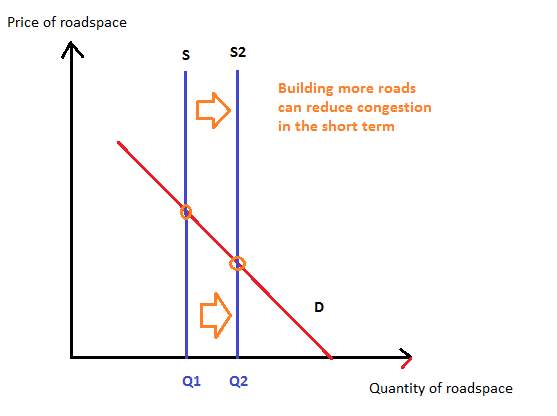

A3
Arguments for and against a congestion tax are summarised in the table below,
| Stakeholders | Advantages | Disadvantages |
| Motorists |
|
|
| Broader Public |
|
|
| Businesses |
|
|
| Governments |
|
|
A4
- Increased options in alternative modes of transport leads to a decrease in the demand for driving into the CBD. D1 shifts left to D2.
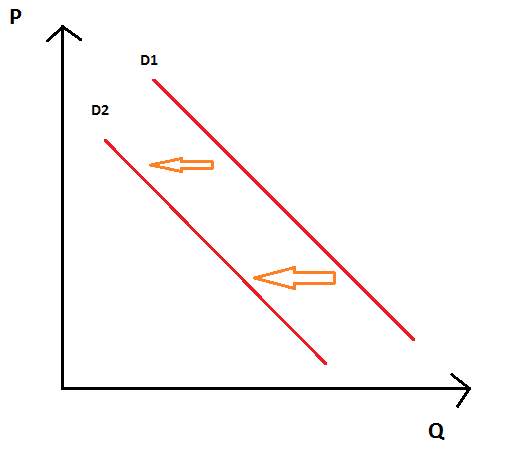
- The congestion charge will increase the private marginal cost curve by the value of the tax ($5). If the tax is priced at the socially optimal value, the new equilibrium point will be closer to the intersection of the marginal social cost curve and the marginal private benefit curve (also known as private demand).
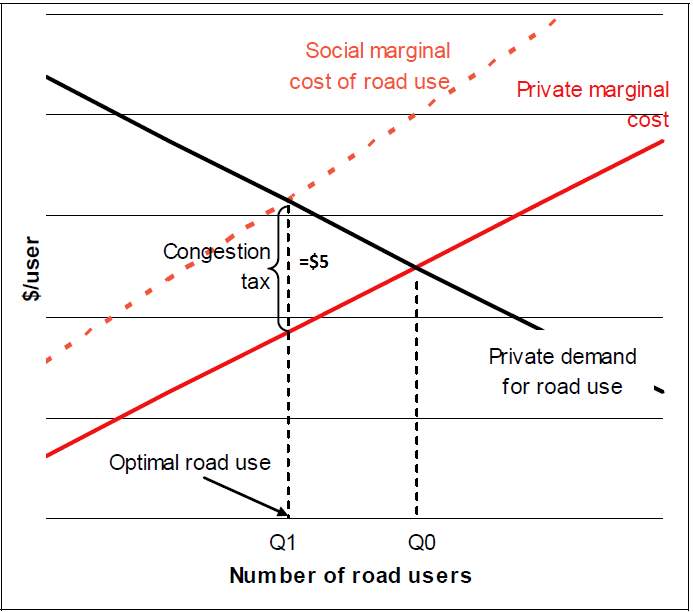
Figure 6: Plot illustrating the external cost of congestion – edited from (Manners 2014)
c) If the congestion tax is higher then the socially optimal point then a dead weight loss will be created by the tax.
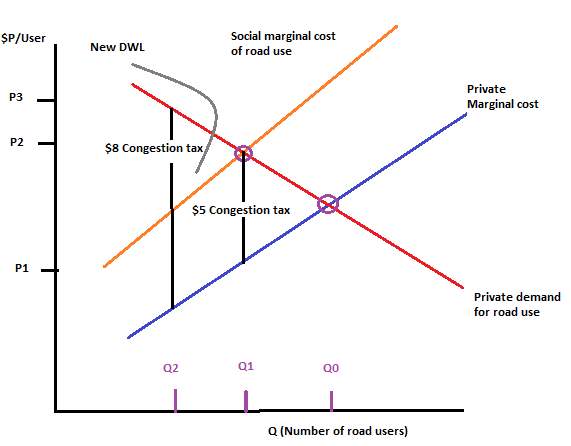
Discussion Point
The following flow diagram demonstrates how the application of a congestion tax can improve social welfare. List the assumptions made through the chart for this to be applicable for the Australian context.
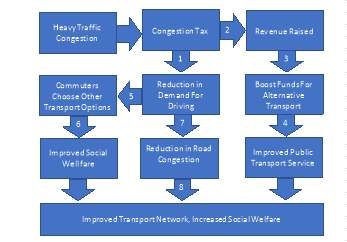
Answers/Ideas:
- Motorists are price sensitive.
- Funds raised from taxing congestion are higher than the cost of regulating the tax.
- Governments reallocate revenue appropriately.
- Would assume investment levels outstrip growth in demand.
- The demand for driving is highly elastic.
- Alternative transport options have a lower marginal social cost when compared to driving.
- Effects of population growth is accounted for.
- The gains from increased productivity outstrip the social cost of a congestion tax.
Reference List
Arnott, R. and M. Kraus (1998). “When are anonymous congestion charges consistent with marginal cost pricing?” Journal of Public Economics 67(1): 45-64.
Australian Bureau of Statistics (2015) “Distance travelled by Australian passenger vehicles in 2012”, Australian Bureau of Statistics
Beevers & Carslaw, (2005) “Impact of Charging on Emissions,” Atmospheric Environment 39:1
Bureau of Infrastructure Transport and Regional Economics, (2014). “Urban public transport: updated trends” Information sheet:59. Department of Infrastructure and Regional Development Canberra, Australia. From: https://bitre.gov.au/publications/2014/files/is_059.pdf
Bureau of Infrastructure Transport and Regional Economics, (2015). “Traffic and congestion cost trends for Australian capital cities”. Information sheet:74. Department of Infrastructure and Regional Development Canberra, Australia. From: https://bitre.gov.au/publications/2015/files/is_074.pdf
Bureau of Transport and Regional Economics, (2007). “Estimating urban traffic and congestion cost trends for Australian cities”. Working Paper 71. Department of Transport and Regional Services Canberra, Australia. From: https://bitre.gov.au/publications/2007/files/wp_071.pdf
Chin, A. (2000), “Sustainable Urban Transportation: Abatement and control of Traffic Congestion and Vehicular Emissions from Land Transportation in Singapore,” Environmental Economics and Policy Studies 3:372-373
Falcocchio, J. C. (2015). “Road Traffic Congestion : A Concise Guide” Cham, Springer International Publishing.
Fei, S. (2016). “Parking versus public transport subsidies: case study of Nanjing, China.” Transportation Letters 8(2): 90-97.
Frost, P. (2013). “Managing Traffic Congestion”. Victorian Auditor-General’s Report. From: https://www.parliament.vic.gov.au/file_uploads/20130417-Managing-Traffic-Congestion_DsjNkpZZ.pdf
Jansson, J-O. (2008), “Public Transport Policy for Central-City Travel in the Light of Recent Experiences of Congestion Charging,” Research in Transportation Economics 22:182.
Jowit, J. (2002). “Road tolls will fail to reduce congestion”, Financial Times Ltd.:
Kaliakatsou, E. (2010). “Integrated Impact Assessment” Transport for London; Variation Order 1- Final Report. From: http://content.tfl.gov.uk/annex-b-vo1-iia-report.pdf
Leape. (2006). “London Congestion Charge,” Journal of Economic Perspectives Volume 20 Number 4:157
Levine, J. and Garb, Y. (2000). “Evaluating the Promise and Hazards of Congestion Pricing Proposals: an Access Centered Approach” – The Floersheimer Institute for Policy Studies. From: http://citeseerx.ist.psu.edu/viewdoc/download?doi=10.1.1.583.8339&rep=rep1&type=pdf
Lindsey, R. & Verhoef, E. (2000). “Traffic Congestion and Congestion Pricing”. Tinbergen Institute Discussion Paper. TI 2000-101/3. From: https://papers.tinbergen.nl/00101.pdf
Livingstone, (2004) “Challenge of Congestions,” Planning Theory & Practice 5:4:492-493.
Malachy, C. and S. Ashok (1993). “Externalities, Average and Marginal Costs, and Tolls on Congested Networks with Time-Varying Flows.” Operations Research 41(1): 217-231.
Manners, P. (2014). “Congestion pricing: why and how”. Centre of International Economics. From:http://www.thecie.com.au/wp-content/uploads/2014/06/Congestion-pricing.pdf
Moran et al. (2016) “Congestion and Reliability Review”. AP-R534-16. Austroads
Pearce, P. and D. Pinto (2015). “An evaluation of the case for a congestion tax in Australia.” Tax Specialist 18(4): 146-153.
Phang, S-Y. and Toh, R-S. (2004) “Road Congestion Pricing in Singapore: 1975 to 2003,” Transportation Journal 43:16-21.
Phang. (2004) “Road Congestion Pricing,” Transportation Journal 43 (2004): 16-17.
Ridder, Z. (2016). “The efficacy of congestion pricing”, from: https://scholar.utc.edu/cgi/viewcontent.cgi?article=1060&context=honors-theses
Rich, J. and O. A. Nielsen (2007). “A socio-economic assessment of proposed road user charging schemes in Copenhagen.” Transport Policy 14(4): 330-345.
Santos, G. (2005). “Urban Congestion Charging: A Comparison between London and Singapore.” Transport Reviews 25(5): 511-534.
Sendt, R.J. (2006) “The Cross City Tunnel Project”. AUDITOR-GENERAL’S REPORT PERFORMANCE AUDIT.From:http://www.audit.nsw.gov.au/ArticleDocuments/138/152_Cross_City_Tunnel.pdf.aspx?Embed=Y
Small and Gómez-Ibáñez (1998). “Road pricing for congestion management: the transition from theory to policy”. pp. 213-246.
Sumit, A. & Koo, K-M. & Sing, T-F. (2015) “Impact of Electronic Road Pricing on Real Estate Prices in Singapore,” Journal of Urban Economics 90:58
Sweet, M. (2014). “Traffic Congestion’s Economic Impacts: Evidence from US Metropolitan Regions.” Urban Studies 51(10)
Terrill, M. (2017). “Stuck in Traffic? – Road congestion in Sydney and Melbourne” Grattan Institute report No. 2017-10
Thaler, R. H. (2009). Nudge : improving decisions about health, wealth, and happiness. New York, Penguin Books.
The WestConnex Challenge (2017), “Public Summary report” -Draft. From: https://www.cityofsydney.nsw.gov.au/__data/assets/pdf_file/0008/286163/12625_West-Connex-12pp-public-summary-report-June-2017_DE12-singles.pdf
Tuckey, B. (1994). “Report: replace diesel excise with income tax.” Business Review Weekly 16(39): 87.
Watson and Holland, (1976) “The Example of Singapore,” Finance and Development: 21
Cite This Work
To export a reference to this article please select a referencing stye below:
Related Services
View allRelated Content
All TagsContent relating to: "Transportation"
Transportation refers to the process of goods, people or animals being moved from one place to another. There are multiple methods of transport, including train, boat, bus, plane, lorry, and more.
Related Articles
DMCA / Removal Request
If you are the original writer of this dissertation and no longer wish to have your work published on the UKDiss.com website then please:




